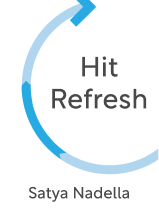

This article is an excerpt from the Shortform book guide to "Hit Refresh" by Satya Nadella. Shortform has the world's best summaries and analyses of books you should be reading.
Like this article? Sign up for a free trial here.
What does “hit refresh” mean in relation to Microsoft? Is it just about Microsoft, or can the principles be applied more broadly?
Hit Refresh is Satya Nadella’s account of how he took over as Microsoft’s CEO in 2014 and sought to rejuvenate the company after a long period of stagnation and decline. He describes how he reinvigorated the company by rediscovering its “soul.”
Keep reading for our Hit Refresh book review.
Hit Refresh Book Review
Nadella rediscovered Microsoft’s soul by articulating the company’s mission and reminding everyone of the why behind their work, by transforming the corporate culture from one plagued with in-fighting to one of collaboration, and by forming strategic partnerships with Microsoft’s fiercest competitors.
Throughout the book, Nadella discusses the key leadership principles that helped him “hit refresh” on Microsoft and the business practices that allowed the company to thrive once again. He connects these principles to his life experiences of growing up in India, immigrating to the US, working his way up at Microsoft, and being a father to a child with special needs. He also offers his thoughts on the future and how companies and policymakers can—and must—ensure that technology isn’t just a means for economic growth but, above all, a force for good that is grounded in empathy, augments (instead of replaces) human capabilities, and helps solve the world’s big problems.
In our Hit Refresh book review, we’ll take a look at the book’s authors, publication, context, impact, critical reception, and organization.
The Book’s Authors
Satya Nadella is only the third CEO of Microsoft in the company’s 47-year history. (His predecessors are Bill Gates and Steve Ballmer.) He grew up in Hyderabad, India, where his father was a civil servant and his mother was a Sanskrit scholar. His first love was cricket, and his sole ambition in his younger years was to play the sport and then work for a bank. However, when he started studying electrical engineering at the Manipal Institute of Technology, cricket took a backseat to his love for computers.
After graduating from college, he immigrated to the US, obtained a master’s degree in computer science at the University of Wisconsin, then worked for Sun Microsystems, a Silicon Valley legend. In 1992, he got a job at Microsoft in Redmond, Washington as a Windows NT evangelist (tech-speak for someone who builds support for specific technologies). Wanting to complement his engineering background with management training, he enrolled in a part-time investment banking program at the University of Chicago, flying in every weekend to attend classes after a full week of work.
Nadella worked in various leadership roles at Microsoft before becoming the executive vice president at the helm of the company’s nascent cloud business. He was announced as the CEO of Microsoft in February 2014. Since then, Microsoft’s market capitalization has increased from around $300 billion to around $2.5 trillion (as of December 2021), and Nadella has been recognized by various award-giving bodies and publications for his leadership: In 2018, he was a Time 100 honoree; in 2019, he was Financial Times’ Person of the Year and Fortune’s Businessperson of the Year; and in 2020, he received the Padma Bhushan, the third-highest civilian award from the Indian government. In 2021, Nadella was named Microsoft’s chairman.
Nadella is married to his childhood friend, Anu. (In the book, he narrates how complicated immigration laws led him to give up his green card (and permanent status in the US) for love—in a risky move, he reapplied for a temporary skilled worker visa, which allowed him to bring Anu to the US from India without a waiting period.) They have three children; his eldest, Zain, was born with cerebral palsy and died in 2022 at the age of 26.
Connect with Nadella:
Nadella co-wrote Hit Refresh with Greg Shaw, a publisher and senior director of the Office of the CEO at Microsoft, and Jill Tracie Nichols, the founder and CEO of a boutique communications agency and Nadella’s former chief of staff.
The Book’s Publication
Hit Refresh was published by HarperCollins in 2017. It includes a foreword by Microsoft co-founder Bill Gates, where he explains the significance of the title: When you hit the refresh button on your browser, you don’t start from scratch; instead, you keep some of the page on your screen. He likens this to how Nadella didn’t turn Microsoft into a completely different company but instead expanded the company’s focus beyond Windows and into exciting new territory.
In an interview, Nadella emphasizes that Hit Refresh isn’t a playbook for success, but rather a reminder of the importance of constantly hitting refresh—reevaluating, recalibrating, and innovating—for sustained success.
The Book’s Historical Context
When Nadella took over as CEO, Microsoft was no longer the tech juggernaut it once was. The company was still profitable, but it failed to break into emerging tech like ebooks and mobile, and it was playing catch-up with its competitors. Internally, the company was plagued with conflict and bureaucracy.
In the book, Nadella references the toxic culture at Microsoft, but he doesn’t go into much detail beyond mentioning in-fighting, finger-pointing, and employee dissatisfaction and disillusionment. Reports describe how executives stifled innovation, refusing to see beyond the company’s tried-and-tested products, Windows and Office.
Apart from that, the dotcom crash led to resentment—while older employees easily earned millions during the dotcom boom, employees post-boom had to contend with cost-cutting measures like scaled-back health insurance. Realizing that the days of dotcom millionaires were over, newer employees became more intent on moving up the corporate ladder. This meant more power plays, more managers, and a bloated organization where everything moved at a snail’s pace—which can be catastrophic for a company in tech.
When Nadella stepped in, he knew that Microsoft needed a refresh. The book describes the changes he made in his first three years as CEO and is interwoven with stories about his journey from Hyderabad to Redmond. He confesses that he had some reservations about writing the book fairly early into his term, saying that there was still a lot of work to do. However, he realized that writing as a sitting CEO in the middle of a big transformation—rather than as a retired CEO with the benefit of hindsight—could help Microsoft’s employees gain a deeper understanding of the company’s mission. He also wanted to share his insights on the wider ethical, political, and economic implications of recent technological breakthroughs.
In a LinkedIn post, Nadella says that the book “isn’t a victory lap or how-to manual” but a set of “reflections, ideas, and principles on transformation,” as well as questions for those who want to improve themselves or their institutions.
The Book’s Intellectual Context
Hit Refresh is similar to other books written by successful business people about their leadership principles and their approach to corporate culture. Other books in this category include:
Principles—Ray Dalio, the founder of the world’s largest hedge fund, writes about how his experience of failure led to his firm’s culture of relentless truth-seeking and radical transparency.
Creativity, Inc.—Pixar co-founder Ed Catmull writes about encouraging candor and nurturing creativity and innovation in the workplace.
No Rules Rules—Netflix CEO Reed Hastings reveals the unorthodox workplace culture of “freedom and responsibility” that allowed the streaming platform to stay innovative and agile in a fast-changing industry. (Incidentally, Hastings—who was a member of the Microsoft board—was a mentor to Nadella when he was still running Microsoft’s online division.)
We’ll compare and contrast the ideas from some of these business people and other similar books with Hit Refresh in this guide.
The Book’s Impact
Hit Refresh was a New York Times bestseller, peaking at #4. Every Microsoft employee was given a special annotated version of the book—though, unlike Ray Dalio’s Principles—it wasn’t required reading.
The Book’s Critical Reception
Positive reviews of the book describe it as unpretentious, stirring, and well-written, providing “surprising and welcome insights into a corporate giant” and as a “valuable blueprint for techies and others in a culture-change state of mind.” On the other hand, one writer opines that the book is a “sanitized rather than revelatory account of change at Microsoft.” Another writer laments that there isn’t much about Microsoft’s history. The Financial Times writes that Nadella’s natural restraint, unfortunately, keeps him from going into compelling detail—whether it’s about his experiences at work or at home.
The Book’s Organization
Nadella tells his story in three broad sections: He writes about the past (his formative years in India and his move to the US), the present (Microsoft’s ongoing transformation), and the future (his reflections on the implications of the development of AI). He accomplishes this through a loosely organized blend of memoir, scattered business anecdotes, and ethical, political, and philosophical musings.

———End of Preview———
Like what you just read? Read the rest of the world's best book summary and analysis of Satya Nadella's "Hit Refresh" at Shortform.
Here's what you'll find in our full Hit Refresh summary:
- How Satya Nadella brought Microsoft back from its decline
- Actionable advice to help you reinvigorate your company
- A look at the ethical responsibilities of tech companies






